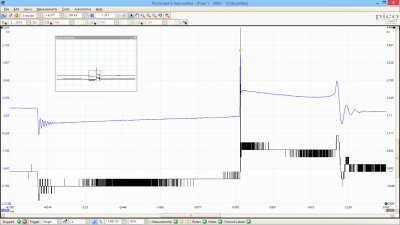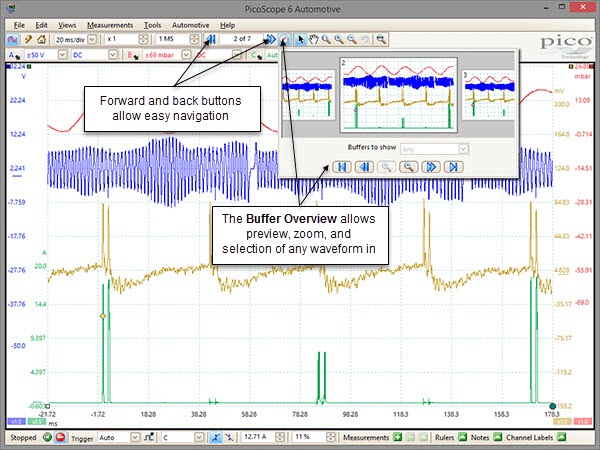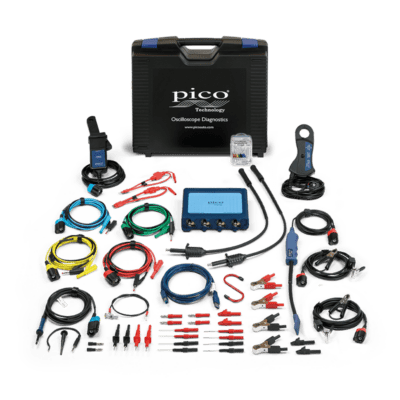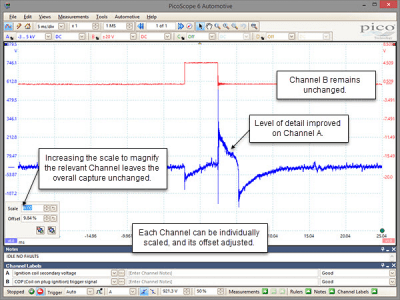Key Specifications - Which Oscilloscope is Best?
Update: Added comparison to a professional OBD tool scope facility - Scope C
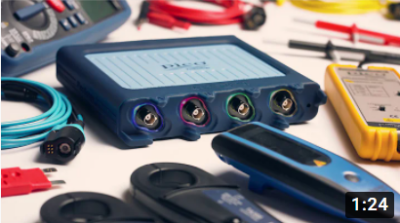
An oscilloscope is an essential workshop tool. There are many scopes on the market, so how do you choose the best for your application?
The answer is found in the scope's specifications - that boring list of figures lurking at the back of the scope's datasheet! Consumers make many buying decisions based exclusively on price. Your ability to diagnose problems will be compromised and the return on your investment will be diminished, if an inferior scope is purchased.
Diagnostic tools incorporating an Oscilloscope
Many diagnostic tools or system analysers incorporate an oscilloscope function but these instruments rarely meet the specifcations of the PicoScope. An analogy might be useful: A shifting spanner can fit many different sized bolts and nuts but a fixed-sized specialist socket or spanner is usually preferred. An example is a popular German system costing about R180,000 which contains a two channel scope capable of sampling at 50MS/s. The PicoScope can sample at up to 400MS/s, eight times better at a fraction of the price, and the 4425A has four channels!
Diagnostic Tools
An oscilloscope works with and is not a replacement for an OBD diagnostic tool or system analysers. OBD tools and analysers are both useful and necessary and should be used to provide early indication of fault locations and, of course, to run diagnostics and reset fault codes.
In this application note, we have taken some important specifications of the PicoScope 4425A and compared them with two competing 4-channel scopes, Scope A and Scope B, highlighting differences. We hope that this will help you in evaluating any competing scopes to find the one that is best for you.
OBD Tool Scope Facility (Scope C)
We have also included a 2-channel scope facility provided with a popular, professional diagnostic tool for comparison and called it Scope C. (We also supply a 2-channel Automotive PicoScope called the 4225A which has similar specifications to the 4-channel 4425A used in this article.)
Vertical Resolution
The PicoScope 4425A and Scope A have 12 bits of vertical resolution. Scope B has only 8 bits and Scope C has 10 bits.
Why do I care?
To the uninitiated, that might not seem to be a huge difference, but is it? An 8 bit scope can only measure 256 levels whereas a 10 bit scope can measure 1,024 levels and a 12 bit scope can measure 4,096 levels. A 12 bit scope (PicoScope) has 16 times the resolution of an 8 bit scope and 4 times the resolution of a 10 bit scope.
Effect on Bandwidth
An oscilloscope uses an Analogue to Digital Converter (ADC) to transform signals into numbers. 8 bit ADCs are far less expensive and faster than 12 bit ADCs which is why Scope B has a bandwidth of 70MHz whereas the PicoScope 4425A and Scope A have a bandwidth of 20MHz. We have chosen relatively fast automotive scopes for this analysis. We believe that 20MHz is adaquate for most automotive diagnostics. Please be aware that there are many scopes on the market with much lower bandwidths which will not be able to display fast signals at all.
This problem is highlighted in Scope C. The PicoScope has 200 times the bandwidth of Scope C which only has 100KHz bandwidth.
Sampling Rate
Watch the Video
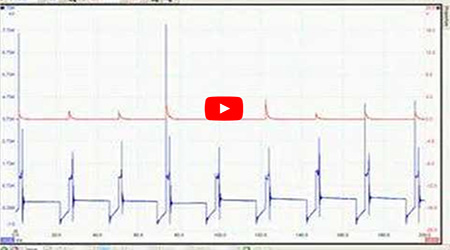
Watch the video above to see how the display is improved as the number of samples is increased. Events such as the ignition spikes and oscillations are invisible at low sample rates and gradually come into view as the sample rate is increased. Eventually, at high sample rates, you can even measure the width (spark ionisation breakdown time) and amplitude (peak ionisation voltage) of the high voltage spikes. You can count the number of oscillations that occur as current stops flowing - an important indicator of the health of the coil.
This specification tells you how many times the scope can capture and record measurements in a second. This is important In situations such as examining fast pulses (e.g. ignition pulses) or trying to determine precise timing relationships.
PicoScope 4425A (12 bits)
The PicoScope can sample 12 bits at up to:
- 400 million samples per second (MS/s) if one channel is used,
- 200 MS/s if two channels are used and
- 100 MS/s if 3 or 4 channels are used.
Scope A (12 bits)
Scope A can sample 12 bits at up to:
- 80 MS/s if 1 or 2 channels are used and
- at 20 MS/s if 3 or 4 channels are used.
Scope B (8 bits)
Scope B can sample 8 bits at 1 giga samples per second (GS/s) which is more than twice as fast as the PicoScope. However, this specification is achieved at the expense of vertical resolution which is 16 times poorer.
Scope C (10 bits)
Scope C can sample at up to 40MHz which is only 10% of the PicoScope.
Why do I care?
The PicoScope can take five samples for evey one sample that Scope A can take and ten samples for evey one sample that Scope C can take. This allows you zoom into and examine events that may be missed completely by slower scopes. The huge reduction in vertical resolution (16:1) in Scope B is a high price to pay for a doubling of horizontal resolution.
Buffer Memory
The buffer memory is used to store measurements (samples) taken by the scope so that they can be displayed. The size of the buffer is a critical performance specification that cannot be over-emphasised.
- PicoScope: 250 M Samples
- Scope A: 32 M Samples
- Scope B and C: 64 K Samples
The differences are huge! The PicoScope can capture almost 8 times the samples compared to Scope A and more than 3,000 times the samples compared to Scopes B or C.
Why do I care?
Many automotive problems reveal themselves over a long period of time. You can setup the PicoScope to record signals (e.g. the Mass Airflow Sensor, Primary Ignition and / or the Lambda Sensor) over a long period, e.g. whilst the engine warms up, and review what happened. The PicoScope allows you to zoom in and examine the event in detail.
This does not only apply to long term events. The huge buffer combined with the high sampling rate allows you to examine short-duration events in great detail.
Waveform Buffers
The PicoScope allows up to 10,000 waveforms to be stored. Scope A allows 1,000 and Scope B and C do not specify any waveform buffer (we therefore assume that only the current screen, 1 buffer is provided).
Why do I care?
Every time the scope captures new data, that data is stored in a waveform buffer. You can review previous waveforms to find the event you are looking for. PicoScope 6 software has a powerful waveform navigator to allow you to scroll through previous waveforms efficiently.
Conclusion
We have presented only a few key specifications here. There are many other specifications to check such as the maximum input voltage, channel isolation (independant grounds), etc. If you are having trouble understanding anything, please contact us and we will try to assist. Bear in mind that you don't interact with the scope as it is merely a place to plug in your test leads; you interact with the PC. Don't forget to include a comparative analysis of the software, with special emphasis on ease of use, when deciding which is the best scope for you.
The PicoScope is not a replacement for your current diagnostic tools. It works with them and improves your diagnostic capabilities which means that you can solve problems faster and more efficiently.
© Copyright 2018 Garage Lube (Pty) Ltd

